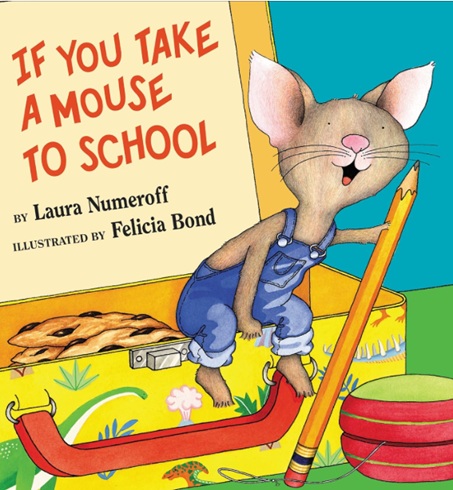Author: Laura Numeroff
Illustrator: Felicia Bond
Publisher: HarperCollins Publishers
Year: 2002
Language: English
Type of resource: Illustrated picture book
Themes: School, daily routines, curiosity, friendship
Age range: 6–10 years
School levels: 1st–5th Grade (Elementary School)
Main learning objective: Develop listening comprehension and expand vocabulary related to school life.
Main language objective: I can talk about school objects and activities.
Summary of the Book
This picture book tells the story of a young boy who takes a mouse to school. But this unpredictable mouse causes a series of funny events: she asks for school supplies, explores the classroom, conducts science experiments, plays with building blocks, reads, and even writes a book. The day is filled with discoveries and activities, until she needs her lunchbox… bringing the story full circle in a humorous loop. This succession of actions introduces children to a wide range of vocabulary related to school life and daily routines.
Culture and Vocabulary
This book presents the American school context: personal lockers, lunchboxes brought from home, various classroom activities (math, science experiments, recess sports), and the school bus system. These objects and habits may not always be familiar to students from other countries. The book provides a great opportunity to compare school practices: individual lunchboxes vs. school cafeterias, personal lockers vs. coat hooks, and the importance of school sports (soccer, basketball). These cultural differences can stimulate intercultural discussions in the classroom.
School objects: lunchbox, notebook, backpack, locker, pencils, books, paper
Places and school activities: lunchroom, bathroom, classroom, science experiment, building blocks, math, spell a word
Games and sports: soccer, basketball, skateboarding
Action verbs: give, ask, share, build, read, write, run, play, wash up
Key expressions: take a look around, catch his breath, tuck it in a safe place
Grammar and Structures
- Hypothetical future with “If…”: “If you take a mouse to school, he’ll ask you for your lunchbox.” – Introduces simple conditional structure.
- Simple future with “will”: “He’ll want a sandwich.” – Expresses an expected action.
- Implicit progressive form: “While he’s waiting, he’ll play a quick game of soccer.” – Shows simultaneous actions.
- Contractions: “He’ll want a sandwich” – Introduces common English contractions (he will → he’ll).
- Simple present: “He needs a notebook.” – Good for discussing needs and habits.
- Imperative (implicit): “See if you can guess.” – Encourages oral interaction.
- Compound nouns: lunchbox, backpack – Highlights frequent compound words in school vocabulary.
Phonology
- Repetition and rhythm: “He’ll want… He’ll need… He’ll probably…” – Helps with sound recognition and intonation.
- Contrasting sounds /ʊ/ vs /uː/: lunchbox vs school – Useful listening exercise for French-speaking learners.
- Alliteration: “building blocks” – Can be used for sound or phoneme games.
- Focus on [s] and [ʃ] sounds: school, sandwich, snack – Reinforces articulation of common sounds.
- Internal rhymes and narrative rhythm: Supports memorization and musicality of language.
- Sound contrasts: lunchbox vs lunchroom – Useful for auditory discrimination.
Teaching Suggestions
Before Reading
- Observe the cover and make predictions: Who is this? Where is he going? What will happen at school?
- Introduce school-related vocabulary using flashcards or real objects.
During Reading
- Show the illustrations and ask simple questions: What is he doing? What does he need?
- Have students mime the actions: build, write, play soccer.
- Encourage predictions before turning the page: What do you think he will ask for next?
After Reading
- Reconstruct the mouse’s day using pictures.
- Play a memory/matching game with classroom objects.
- Role-play scenes where the mouse asks for items.
Grammar Mini-Lesson
- Practice the conditional structure “If you… he/she/it will…” by creating funny new sentences: If you take a dog to the park… If you take a cat to school, it will…
- Work on school-related vocabulary with my: my notebook, my pencils.
- Raise awareness of contractions: he’ll, he’s – pronunciation and meaning.
Differentiation
For beginners: focus on short, repetitive oral activities with visual support (miming, flashcards). For more advanced students: rewrite a page by changing the main character or object, or invent a continuation using simple conditional structures. For autonomous learners: create a mini illustrated book with their own ideas.
Cross-Curricular Connections
Art: Design the “ideal lunchbox” using paper and drawings of food.
Science: Conduct a simple experiment (baking soda volcano).
Physical Education: Play sports featured in the story (soccer, basketball) while using English instructions.
Civic Education / Social Skills: Discuss cooperation and helping others at school.
Media and Information Literacy: Compare an American and a French school timetable.
Project Ideas / Extensions
Project Workshop: A Day at School for the Mouse
Objective: Create a collective illustrated journal showing the steps of a school day using English vocabulary. Each group illustrates a scene and writes a simple sentence in English.
Exploring Other Books: Read If You Give a Mouse a Cookie or Cat and Mouse Go to School to expand vocabulary and practice the same repetitive structure.
Conclusion
If You Take a Mouse to School is a rich picture book, ideal for introducing or reinforcing school-related vocabulary in English while raising awareness of cultural differences. Its repetitive structure and engaging illustrations make it a perfect resource for interactive, oral, and differentiated classroom activities.







